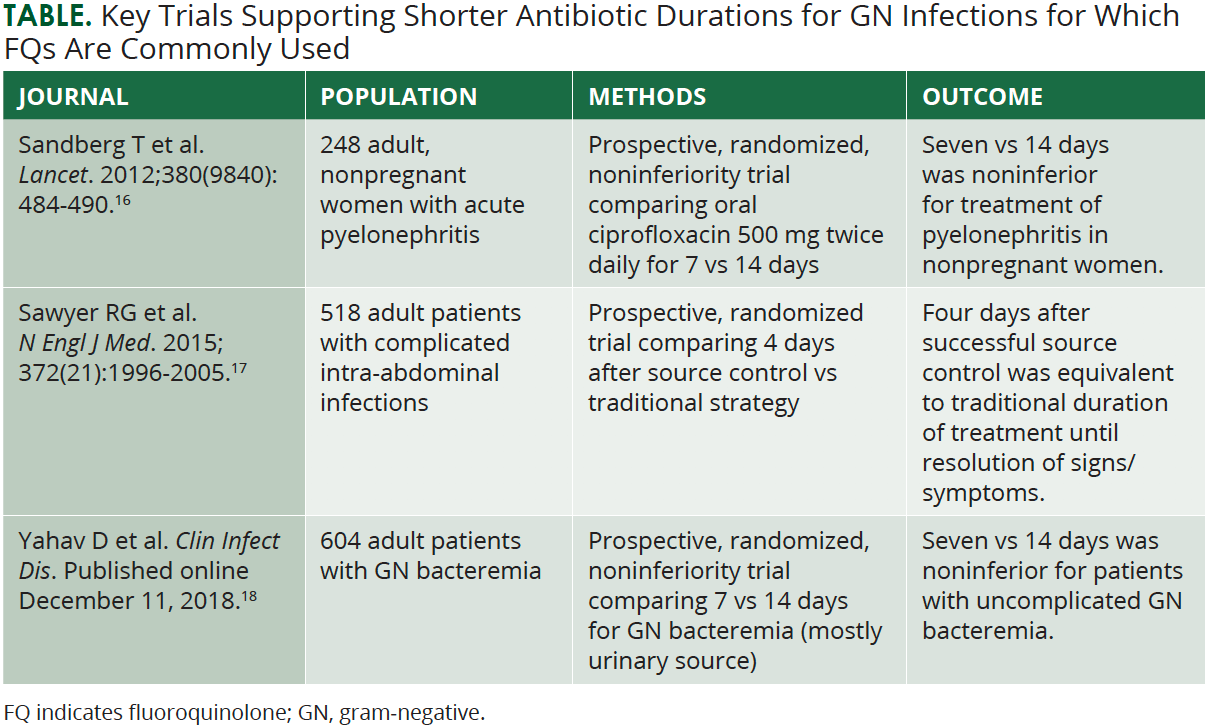Future of Fluoroquinolones: Risks, Benefits of Antibiotic Workhorse
Warnings and concerns regarding fluoroquinolones are on the rise, but the antibiotics still play a role, albeit more limited, in the treatment of various infectious diseases.
In the past decade, fluoroquinolones (FQs) have significantly fallen out of favor as empiric usage for many gram-negative (GN) infections. The US Food and Drug Administration (FDA) has issued statements regarding preferential use of alternative therapy for many common disease states because the risks of adverse effects (AEs) of FQs outweigh the potential benefits. A 21-member FDA advisory panel convened in November 2015 to discuss FQ use for common infectious indications. The overall consensus was to avoid FQs for acute bacterial sinusitis, acute chronic obstructive pulmonary disease exacerbations, and uncomplicated urinary tract infections unless no alternative treatments exist.1 For these diseases, there are other effective options that are considered safer and to have less propensity for collateral damage.2
Current FDA boxed warnings for the FQ class include myasthenia gravis (MG) exacerbation as well as serious adverse reactions, including effects on the central nervous system (CNS), tendinitis, tendon rupture, and peripheral neuropathy.1,3 FQs can also result in corrected QT prolongation with a risk, albeit low, of torsade de pointes. Other recent warnings from the FDA have included glucose homeostasis disturbances and a risk of aortic aneurysm and aortic dissection.4,5 The proposed mechanisms by which FQs can exacerbate MG include alteration of neural transmission at neuromuscular junctions and FQ chelation of calcium, which inhibits acetylcholine release presynaptically. A literature search of the FDA Adverse Event Reporting System database in 2011 found 37 reported cases, with a median of 1 day from the start of FQ therapy to exacerbation of MG symptoms. Dyspnea was reported as the most common symptom of the exacerbation.6 It seems prudent to avoid FQs in patients with MG despite lack of concrete evidence of the mechanism of exacerbation induction.
FQs affect the CNS by their actions on GABAA and N-methyl-D-aspartate receptors and can result in attention disturbance, disorientation, agitation, nervousness, memory impairment, delirium, and seizures. These effects may be worsened if there is poor renal function, resulting in higher serum concentrations of the drugs, or if the blood—brain barrier is compromised in any way.1,7 The risk of tendinitis and tendon rupture has been demonstrated in several studies and was first reported in 1983. These effects most often occur in the Achilles tendon and are more of a concern for patients over 60 years and those with poor renal function. The mechanism is likely due to alterations in collagen formation.8,9 Patients taking FQs should be counseled to avoid rigorous physical activity to reduce their risk of tendon-related AEs.
A recently recognized AE of FQs is aortic aneurysm and dissection. A study in Denmark compared a cohort of patients who received FQ antibiotics over a 7-year period with a control group who received amoxicillin. The investigators found a significantly increased risk (HR, 1.66; 95% CI, 1.12- 2.46) of aortic dissection or aneurysm within 60 days of use in the group who received FQs versus those receiving amoxicillin. Almost half of the cases happened within the first 10 days after starting a FQ versus any other 10-day increment. The risk of death from any cause was similar between the 2 groups (HR, 1.02; 95% CI, 0.97-1.08).5
Dysglycemia can occur with any FQ, although some have been implicated more than others. A study of more than 70,000 diabetic patients in Taiwan receiving FQs, cephalosporins, or macrolides found that there was an increased risk of both hypo- and hyperglycemia in patients receiving FQs versus other classes of antibiotics. In fact, gatifloxacin was withdrawn from the market because of its association with dysglycemia, leading to hospitalizations and even death, particularly in older adults.10 Of the currently available FQs, the risk appears to be highest with moxifloxacin.11
Moreover, FQ resistance has been on the rise for years and has been shown to be linked with prior FQ usage. A recent study in Israel evaluated patients for the risk of FQ-resistant Escherichia coli (colonization or infection) based on FQ use in their geographic area. Patients had an increased prevalence of FQ resistance if they had used FQs, as did those in the same neighborhoods with higher FQ use.12
Despite warnings, providers still commonly prescribe FQs as first-line treatment for many uncomplicated indications. In fact, FQs are the fourth-most commonly prescribed antibiotic class in the United States; in 2014, 32.8 million prescriptions for FQs were issued.13 Unnecessary overuse is likely due to the ease of dosing, adequate tissue penetration and serum levels, lack of cross-reactivity in patients with a β-lactam allergy, and years of experience with these agents. It is possible that not all providers have received the negative messages. Caution should be taken when prescribing FQ antibiotics, especially to elderly patients and those with poor renal function, although not all AEs are correlated with higher serum concentrations. Also, many AEs have been reported to occur early in treatment, indicating that even short courses may be harmful.
Nevertheless, FQs certainly continue to play an important role, particularly for severe infections due to GN bacteria, including pyelonephritis, bacteremia, biliary tract or intra-abdominal infections, pneumonia, bone and joint infections, endocarditis, and even CNS infections. Risks of FQ toxicity may be outweighed by the benefit of FQs’ high oral bioavailability, allowing patients with functioning gastrointestinal tracts to receive an oral therapy. Many of these patients would otherwise need intravenous antibiotics administered via a peripherally inserted central catheter line or other longer-term venous access. Two important recently published studies, one on infective endocarditis and the other on bone and joint infections, both incorporated a number of oral FQs for many of the antibiotic regimens because of their pharmacokinetic properties.14,15
Lastly, a growing body of evidence is available to support shorter antibiotic durations for many GN infections, therefore limiting the time of exposure and vulnerability to FQ-induced toxicity. The Table describes 3 important studies evaluating primarily GN infections that support shorter durations of therapy.

To preserve the utility of these agents and keep patients safe, institutions should restrict FQ use to appropriate indications, and outpatient providers should be held accountable for unnecessarily prescribing this class of antibiotics. FQs are a highly valuable antibiotic class, but because of concerns for resistance and AEs, they should be reserved for compelling indications, particularly when safer and equally effective alternatives exist.
Rose received a PharmD at Massachusetts College of Pharmacy & Health Sciences, completed a PGY-1 pharmacy practice residency at UMassMemorial Health Care, and a PGY-2 infectious diseases pharmacotherapy residency at The Brooklyn Hospital Center. She is currently the co-director of the Antimicrobial Stewardship Program at Cooper University Hospital in Camden, New Jersey, and is as an adjunct professor at Cooper Medical School of Rowan University and University of the Sciences.King is an assistant professor of pharmacy at Philadelphia College of Pharmacy and a Board Certified Infectious Diseases pharmacist. She precepts pharmacy students and residents on clinical, research, and public health rotations, and works closely with the infectious diseases team at Cooper University Hospital. *She is an active member of the Society of Infectious Diseases Pharmacists.
References:
- US Food and Drug Administration. FDA Drug Safety Communication: FDA updates warnings for oral and injectable fluoroquinolone antibiotics due to disabling side effects. FDA website. www.fda.gov/Drugs/DrugSafety/ucm511530.htm. Published July 26, 2016. Updated December 20, 2018. Accessed March 1, 2019.
- Paterson DL. “Collateral damage” from cephalosporin or quinolone antibiotic therapy. Clin Infect Dis. 2004 May 15;38 Suppl 4:S341-5. doi: 10.1086/382690.
- UD Food and Drug Administration. FDA warns about increased risk of ruptures or tears in the aorta blood vessel with fluoroquinolone antibiotics in certain patients. FDA website. www.fda.gov/Drugs/DrugSafety/ucm62875htm. Published December 20, 2018. Updated February 1, 2019. Accessed March 5, 2019.
- US Food and Drug Administration. FDA reinforces safety information about serious low blood sugar levels and mental health side effects with fluoroquinolone antibiotics; requires label changes. FDA website. www.fda.gov/Drugs/DrugSafety/ucm611032.htm. Published July 10, 2019. Updated August 30, 2018. Accessed March 5, 2019.
- Pasternak B, Inghammar M, Svanström H. Fluoroquinolone use and risk of aortic aneurysm and dissection: nationwide cohort study. BMJ. 2018 Mar 8;360:k678. doi: 10.1136/bmj.k678.
- Jones SC, Sorbello A, Boucher RM. Fluoroquinolone-associated myasthenia gravis exacerbation: evaluation of postmarketing reports from the US FDA Adverse Event Reporting System and a literature review. Drug Saf. 2011 Oct 1;34(10):839-47. doi: 10.2165/11593110-000000000-00000.
- Grill MF, Maganti RK. Neurotoxic effects associated with antibiotic use: management considerations. Br J Clin Pharmacol. 2011 Sep;72(3):381-93. doi: 10.1111/j.1365-2125.2011.03991.x.
- Dalhoff A, Schubert S, Vente A. Pharmacodynamics of finafloxacin, ciprofloxacin, and levofloxacin in serum and urine against TEM- and SHV-type extended-spectrum-β-lactamase-producing Enterobacteriaceae isolates from patients with urinary tract infections. Antimicrob Agents Chemother. 2017 Apr 24;61(5). pii: e02446-16. doi: 10.1128/AAC.02446-16.
- Daneman N, Lu H, Redelmeier DA. Fluoroquinolones and collagen associated severe adverse events: a longitudinal cohort study. BMJ Open. 2015 Nov 18;5(11):e010077. doi: 10.1136/bmjopen-2015-010077.
- Park-Wyllie L, Juurlink DN, Kopp A, et al. Outpatient gatifloxacin therapy and dysglycemia in older adults. N Engl J Med. 2006 Mar 30;354(13):1352-61. doi: 10.1056/NEJMoa055191
- Chou HW, Wang JL, Chang CH, Lee JJ, Shau WY, Lai MS. Risk of severe dysglycemia among diabetic patients receiving levofloxacin, ciprofloxacin, or moxifloxacin in Taiwan. Clin Infect Dis. 2013 Oct;57(7):971-80. doi: 10.1093/cid/cit439.
- Low M, Neuberger A, Hooton TM, et al. Association between urinary community-acquired fluoroquinolone-resistant Escherichia coli and neighborhood antibiotic consumption: a population-based case-control study. Lancet Infect Dis. 2019 Mar 4. pii: S1473-3099(18)30676-5. doi: 10.1016/S1473-3099(18)30676-5.
- US Centers for Disease Control and Prevention. Outpatient antibiotic prescriptions — United States, 2014. CDC website: www.cdc.gov/antibiotic-use/community/pdfs/Annual-ReportSummary_2014.pdf. Accessed March 5, 2019.
- Iversen K, Ihlemann N, Gill SU, et al. Partial oral versus intravenous antibiotic treatment of endocarditis. N Engl J Med. 2019 Jan 31;380(5):415-424. doi: 10.1056/NEJMoa1808312.
- Li HK, Rombach I, Zambellas R, et al. Oral versus intravenous antibiotics for bone and joint infection. N Engl J Med. 2019 Jan 31;380(5):425-436. doi: 10.1056/NEJMoa1710926.
- Sandberg T, Skoog G, Hermansson AB, et al. Ciprofloxacin for 7 days versus 14 days in women with acute pyelonephritis: a randomised, open-label and double-blind, placebo-controlled, non-inferiority trial. Lancet. 2012 Aug 4;380(9840):484-90. doi: 10.1016/S0140-6736(12)60608-4.
- Sawyer RG, Claridge JA, Nathens AB, et al. Trial of short-course antimicrobial therapy for intraabdominal infection. N Engl J Med. 2015 May 21;372(21):1996-2005. doi: 10.1056/NEJMoa1411162.
- Yahav D, Franceschini E, Koppel E, et al. Seven versus fourteen days of antibiotic therapy for uncomplicated Gram-negative bacteremia: a non-inferiority randomized controlled trial. Clin Infect Dis. 2018 Dec 11. doi: 10.1093/cid/ciy1054.

